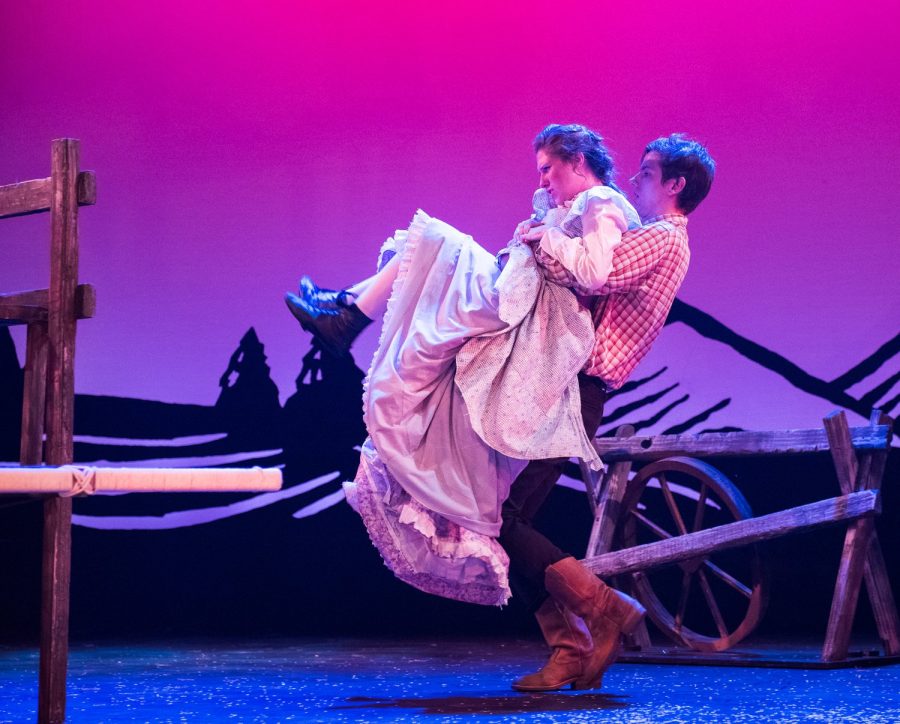The First Musical: How Oklahoma! Created Modern Theatre
Oklahoma!
May 16, 2023
Many know that the musical Oklahoma! was composer Richard Rodgers and lyricist-dramatist Oscar Hammerstein II’s first musical, but few people realize that Oklahoma! wasn’t just the duo’s first successful stab at breaking into the musical theatre world, Oklahoma! effectively created this world.
Oklahoma! is based on the 1931 Lynn Riggs play Green Grows the Lilacs. The adaptation takes place in 1906 Oklahoma and tells the love story of farmgirl Laurey Williams and her suitor Curly McLain. Also thrown into the mix of characters is Aunt Eller, Laurey’s Aunt; outsider Jud Fry, who also has a crush on Laurey; Will Parker, a cowboy who yearns to marry a girl named Ado Annie; Ali Hakim, a Persian trader who becomes involved with this Ado Annies; and Ado Annie herself, a promiscuous girl in love with both Will and Ali.
The show’s complicated love triangles represent something theatre lovers at the time were not at all accustomed to: plot. According to UDiscoverMusic, Rodgers and Hammerstein’s 1943 musical was “the first stage production to seamlessly integrate themes, plot, and character into the score, and was the first musical to release an original cast recording.” Up until this point, plot was reserved for straight plays, and singing and dancing were reserved for feel-good musicals. This “integrated musical” completely redefined what the term musical theatre meant: yes, it had still singing (not to mention a fantastic score), but now it had a plot too which served to give the musical an intrinsic purpose for existing, beyond just pure entertainment.


What a lot of theatre-goers (and even some Oklahoma! fans don’t realize) is that behind the simple story of a farmer and a cowboy is a one about the history of scapegoating in the United States. Our cast of white characters live in Native American territory, and yet, there are no Natives to be seen. The only people who live in this territory are split up into two factions: the farmers and the cowboys. According to Remnants of Wit, despite both groups occupying the same territory and living in a very similar manner, the two groups cannot seem to reconcile their differences. Their only point of contention regards the treatment of the cows; farmers prefer to gate their properties while the cowmen prefer to let their cattle roam free. Both parties say that the other is to blame for the problems that ensue due to this difference. Finally, during the big number “The Farmer and the Cowman”, they finally decide to become friends. This “us” vs. “them” mentality had been previously echoed in Shakespeare’s play, Romeo and Juliet, and would go on to be further explored in future musicals such as Leonard Bernstein’s West Side Story. Rodgers and Hammerstein reminded America of the inherent diversity of its people and how frivolous it is to harp on our differences and blame the other for our grievances.
The scapegoating doesn’t end there. On a smaller scale, the individual characters of Judd Fry and Ali Hakim are “othered” throughout the show. Judd Fry is seen as a perverted villain who is trying to offset the balance and harmony of the town by attempting to seduce Laurey. His schemes scare the townspeople so much that he doesn’t end up surviving to the end of the show. Once he has died, everyone celebrates the overthrow of evil in a dance number akin to “Ding Dong! The Witch is Dead” from The Wizard of Oz. Ali Hakim is the only non-European-American character in the entire show, and just like Jud, he is seen as a perverted outsider, adulterating Will and Ado Annie’s relationship. Both of these individuals represent the treatment of minority groups in the United States during the time of the production; these people were misrepresented, misunderstood, and seen as unequal.
The 2019 Broadway revival of Oklahoma!, directed by Daniel Fish and starring Rebecca Naomi Jones as Laurey and Damon Dauno as Curly, emphasizes the dark undertones like no other production before. Laurey and Curly stand blood-soaked at their own wedding, illustrating the blood on America’s hands due to their treatment of the “outsider.”
Although many modern musical-theatre-goers balk at the idea of seeing and performing in Oklahoma!, its integral place in theatre history is unmatched. The musical was beyond progressive for its time and there is much more to the story than just the surface-level tale of a farmer and a cowboy. You can listen to the 1943 and 2019 Broadway cast recordings of Oklahoma! on Apple Music and Spotify.


















































































































































